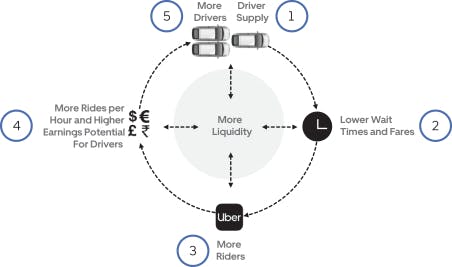Zero-to-one Product Management in Marketplaces

Product management is an exciting and challenging field. Product management in a marketplace, though, is a completely different world with its own unique ups and downs. While there are best practices around what to do during the scale-up or 1 to 100 phases, I am here to talk about what aspects of the product we should pay attention to during the zero-to-one product management at marketplaces.
Throughout my 10+ year career in marketplaces, I was involved in building three businesses. In my previous role at Uber, I worked as a product manager responsible for launching Uber Fleet products globally. While at Dunzo, a delivery app, I led the product launch and expansion team for a ride-sharing product, Dunzo Bike Taxi, in India. I’m currently leading the Platform and Data Engineering Product team at Carwow, an online marketplace for buying and selling cars in London, UK. I’d like to talk about how a product manager can add value during the launch and the zero-to-one phase and share some advice based on my experience.
First, what is a marketplace, and how does it function?
In short, a marketplace is an intermediary that connects demand (end consumers) and supply (sellers or vendors). Recently, technology has accelerated this type of model – think Uber connecting commuters with taxis or Doordash connecting consumers with restaurants. The marketplace, in turn, keeps a percentage of the transaction and calls it a commission or service charge.
So, how does product management fit in?
While it may seem like the role of a product manager does not really change with the phase of growth of an organization, a marketplace might demand an entirely different mindset. More akin to a wartime CEO and peacetime CEO, there could be a Launch Product Manager and Growth Product Manager at a marketplace.
The success of a newly launched marketplace is determined by two things (three if you are not venture-funded):
-
Liquidity – The beauty of marketplaces is how they solve the immediacy of a particular demand. In the Uber example – you want to book a cab immediately rather than days in advance. However, this means keeping demand and supply in sync due to the transient nature of both. Building tools to quickly onboard suppliers and make it easy for customers to sign up is something that products can add plenty of value to.
-
Network effects – If more people use and like the product, the higher the chance they will recommend it to their friends. This in turn creates more demand for sellers or suppliers, thereby increasing the revenue they earn. This can be done through referrals or via user promotions. Both are areas that require product teams to drive.
-
Unit Economics (if sustainability is a focus during launch) – If unit economics is a priority, having tools to configure pricing, user promotions, seller incentives, etc., becomes more important during the launch phase. However, typically, these are areas that venture-funded companies focus on later in the journey after finding the product market fit.
In short, you need a strong product team to tackle all three parts of the marketplace.
How can a Product Manager add value during launch and the zero-to-one phase?
However, a lot can go wrong with how product managers handle a launch. Assuming you are the PM, or a small group of PMs, involved in launching a new marketplace, or a new category or geography within an existing marketplace, here are things that you should be doing.
- Do not go overboard with the interface– Good enough is excellent, and excellent is overkill when it comes to the design and the UI during launch. Users and sellers will not care what color your logo is as long as they can get the intended outcome from the platform (e.g., moving from point A to B for consumers and earning additional income for suppliers). Keep it simple and use the limited resources elsewhere, like the user experience (UX). Yes, UX and UI are not the same, and I learned this the hard way. While building the Uber Fleet app, we tested a few iterations of the UI with end users (fleet partners), and all they cared about was whether they could download a .csv file from the dashboard. No one talked about the font used or the colour of the button.
- Focus on the right side of the marketplace– While the demand-supply equation of a marketplace is very dynamic, there will always be one side to optimize for. Either you have higher demand than supply (more customers than cabs for Uber) or higher supply than demand (more cabs than demand or customers). The marketplace’s job is to balance both sides while trying to grow their profit (or revenue if pre-profit). Product managers must double down and solve this to improve liquidity. There is no sense in optimizing the consumer flow if there are not enough cabs on the road. Focusing on onboarding cabs faster might be a better use of a PM’s time. While launching Dunzo, an on-demand marketplace, we realized this when we had a lot of customer demand but not enough restaurant partners on board, as we had not put enough effort into building the partner onboarding flow.
- Don’t keep customer or partner feedback for later– This is as important during launch as it is later. Your first customers and partners will be your power users in the future and drive network effects later. Knowing and prioritizing their pain points will lead to a better output than building a fancy supply-demand matching algorithm, for example. Trust and safety were a big challenge at Uber, and one of the ways the product could help was by talking with customers and partners regularly. We even had a WhatsApp group of power users at Dunzo who helped give us feedback and identify loopholes in our user promotions.
- Quality over quantity– Building internal tools is part of launching a marketplace. These are internal tools that consumers or suppliers sometimes don’t even see or are aware of. It’s essential to keep them simple and not build everything at once. An interesting use case I found was building an internal promotions tool to configure discounts. It might be wise to just start with flat percentage discounts instead of trying to develop all types of user discounts at once (e.g., buy 2 get 1 free or order 5 times and get the 6th order free). It is important to build a limited set of polished features instead of creating multiple features with inadequate checks and balances.
- Don’t track everything– Analytics should be everyone’s job during launch. However, there is no point in tracking or analyzing data that is not driving the marketplace to grow. For example, the number of customers ordering ice cream between midnight and 4 a.m. is not driving many product decisions during launch unless you are an ice cream marketplace with no supply at night. And even then, it goes back to point #2.
- Experiment, learn, and move on – While experimentation is valuable for improving the product, you might not have enough data available during the launch phase. Keep the experiment simple and quick, if possible, and don’t get obsessed with experimenting with everything. Relying on your gut or instincts might be better at this stage; however, it is not recommended with significant changes once the company has found a product market fit.
A few other things to keep in mind for Product Managers
-
Stay connected to the business strategy. The product roadmap should be based on the direction the business wants to take. For example, if the business strategy is to acquire enterprise suppliers instead of small or independent contractors, the product should reflect that.
-
Keep everyone in the loop. It is vital to let stakeholders know what’s coming. Often, product changes need to be complemented by changes to other processes that the product team might not be even aware of. For example, customer service FAQs.
-
Get involved with your customers and partners. Keeping a close relationship with a few power users and partners will shorten the feedback cycle and help iterate and improve the product faster.
-
Encourage dogfooding. It is imperative that at least the leadership team are power users of the marketplace. In the case of a B2B or low-frequency marketplace, it is important to keep testing the user flow through a test account that everyone can access. There are a lot of valuable insights and feedback that can be derived from dog-fooding, especially in the early stages.
Overall, being a product manager during launch is like walking a tightrope over Niagara Falls. It is pretty rewarding when done right, however deadly if you focus on the wrong things. I hope you found these tips valuable and please let me know if you agree or disagree with them.




